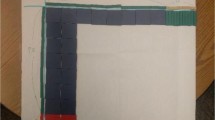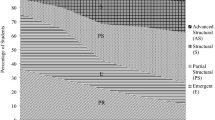Abstract
According to the design principle of progressive schematization, learning trajectories towards procedural rules can be organized as independent discoveries when the learning arrangement invites the students first to develop models for mathematical concepts and model-based informal strategies; then to explore the strategies and to discover pattern for progressively developing procedural rules. This article contributes to the theoretical and empirical foundation of the design principle of progressive schematization by empirically investigating students’ individual schematization pathways on the micro-level for the specific case of part-of-part determination of fractions. In design experiments series in laboratory settings, nine pairs of sixth graders explored the part-of-part determination and progressively schematized their graphical strategies before discovering the procedural rule. The qualitative in-depth analysis of 760 min of video shows that progressive schematization is a multi-facetted process that cannot be described by internalization of graphical procedures alone. Instead, the compaction of concepts- and theorems-in-action is crucial, especially for the goal of justifiable procedural rules.






Similar content being viewed by others
References
Aebli, H. (1981). Denken: das Ordnen des Tuns. Band II: Denkprozesse. Stuttgart: Klett.
Barzel, B., Leuders, T., Prediger, S., & Hußmann, S. (2013). Designing tasks for engaging students in active knowledge organization. In A. Watson, M. Ohtani, et al. (Eds.), ICMI study 22 on task design—Proceedings of the study conference (pp. 285–294). Oxford: ICMI.
Behr, M., Cramer, K., Post, T., & Lesh, R. (2009). Rational number project: Initial fraction ideas. Online-Book. Minneapolis. University of Minnesota. Retrieved from http://www.cehd.umn.edu/ci/rationalnumberproject/rnp1-09.html.
Buijs, K. (2008). Leren vermenigvuldigen met meercijferige getallen. Utrecht: Freudenthal Institute.
Cobb, P., Confrey, J., diSessa, A., Lehrer, R., & Schauble, L. (2003). Design experiments in education research. Educational Researcher, 32(1), 9–13. doi:10.3102/0013189X032001009.
Cramer, K., & Bezuk, N. (1991). Multiplication of fractions: Teaching for understanding. Arith Teach, 39(3), 34–37.
Freudenthal, H. (1981). Major problems of mathematical education. Educational Studies in Mathematics, 12(2), 133–150. doi:10.1007/BF00305618.
Freudenthal, H. (1991). Revisiting mathematics education. Dordrecht: Kluwer.
Glade, M. (2016). Individuelle Prozesse der fortschreitenden Schematisierung—Empirische Rekonstruktionen zum Anteil vom Anteil. Wiesbaden: Springer. doi:10.1007/978-3-658-11254-7.
Gravemeijer, K., & Cobb, P. (2006). Design research from a learning design perspective. In J. Van der Akker, K. Gravemeijer, S. McKenny, & N. Nieveen (Eds.), Educational design research (pp. 17–51). London: Routledge.
Gravemeijer, K., & Doorman, M. (1999). Context problems in realistic mathematics education: A calculus course as an example. Educational Studies in Mathematics, 39(1–3), 111–129. doi:10.1023/A:1003749919816.
Harun, H. Z. (2011). Evaluating the teaching and learning of fractions through modelling in Brunei (Doctoral dissertation). University of Manchester, UK. Retrieved from https://www.escholar.manchester.ac.uk/api/datastream?publicationPid=uk-ac-man-scw:119340&datastreamId=FULL-TEXT.PDF.
Krämer, S. (2003). “Schriftbildlichkeit” oder: Über eine (fast) vergessene Dimension der Schrift. In H. Bredekamp & S. Krämer (Eds.), Bild, Schrift, Zahl (pp. 157–176). München: Fink.
Lorange, C. A., & Rinvold, R. A. (2013). Levels of objectification in student’s strategies. In B. Ubuz, C. Haser, & M. A. Mariotti (Eds.), Proceedings of the 8th Congress of the European Society for Research in Mathematics Education (pp. 323–332). Ankara: METU University / ERME.
Lorange, C. A., & Rinvold, R. A. (2014). Students’ strategies of expanding fractions to a common denominator—a semiotic perspective. Nord Math, 19(2), 57–75.
Prediger, S. (2013). Focussing structural relations in the bar board—a design research study for fostering all students’ conceptual understanding of fractions. In B. Ubuz, Ç. Haser, & M. A. Mariotti (Eds.), Proceedings of the 8th Congress of the European Society for Research in Mathematics Education (pp. 343–352). Ankara: METU University / ERME.
Prediger, S., & Link, M. (2012). Fachdidaktische Entwicklungsforschung - Ein lernprozessfokussierendes Forschungsprogramm mit Verschränkung fachdidaktischer Arbeitsbereiche. In H. Bayrhuber, U. Harms, B. Muszynski, B. Ralle, M. Rothgangel, L.-H. Schön, H. Vollmer, & H.-G. Weigand (Eds.), Formate Fachdidaktischer Forschung (pp. 29–46). Münster: Waxmann.
Prediger, S. & Schnell, S. (2014). Investigating the dynamics of stochastic learning processes: A didactical research perspective. In E. J. Chernoff & B. Sriraman (Eds.), Probabilistic thinking (pp. 533–558). Dordrecht: Springer. doi:10.1007/978-94-007-7155-0_29.
Prediger, S., Schink, A., Schneider, C., & Verschraegen, J. (2013). Kinder weltweit—Anteile in Statistiken. In S. Prediger, B. Barzel, S. Hußmann, & T. Leuders (Eds.), Mathewerkstatt 6 [Textbook for Grade 6] (pp. 143–164). Berlin: Cornelsen.
Prediger, S., Gravemeijer, K., & Confrey, J. (2015). Design research with a focus on learning processes—an overview on achievements and challenges. ZDM Mathematics Education, 47(6), 877–891. doi:10.1007/s11858-015-0722-3.
Radford, L. (2012). Early algebraic thinking: Epistemological, semiotic and developmental issues. Paper presented at ICME, Seoul, South Korea. Retrieved from http://www.icme12.org/upload/submission/1942_F.pdf
Stegmaier, W., & Herrmann, T. (1992). Schema, Schematismus. In J. Ritter & K. Gründer (Eds.), Historisches Wörterbuch der Philosophie (pp. 1245–1263). Basel: Schwabe.
Streefland, L. (1991). Fractions in realistic mathematics education: A paradigm of developmental research. Dordrecht: Kluwer.
Treffers, A. (1979). Cijferend vermenigvuldigen en delen: (1) overzicht en achtergronden. Utrecht: Instituut Ontwikkeling Wiskunde Onderwijs.
Treffers, A. (1987). Three dimensions. A model of goal and theory description in mathematics instruction. Dordrecht: Reidel.
UNESCO (2009). Education for all in least developed countries. Montreal: UNESCO Institute for Statistics. Retrieved from http://www.uis.unesco.org/Education/Pages/gender-education.aspx → survival rate
van den Heuvel-Panhuizen, M. (2001). Realistic mathematics education in the Netherlands. In J. Anghileri (Ed.), Principles and practices in arithmetic teaching (pp. 49–63). Buckingham: Open University Press.
van den Heuvel-Panhuizen, M. (2003). The didactical use of models in Realistic Mathematics Education: An example from a longitudinal trajectory on percentage. Educational Studies in Mathematics, 54(1), 9–35. doi:10.1023/B:EDUC.0000005212.03219.dc.
van Galen, F., Feijs, E., Figueiredo, N., Gravemeijer, K., van Herpen, E., & Keijzer, R. (2008). Fractions, percentages, decimals and proportions. A learning-teaching trajectory for grade 4, 5 and 6. Rotterdam: Sense Publishers.
Vergnaud, G. (1996). The theory of conceptual fields. In L. P. Steffe & P. Nesher (Eds.), Theories of mathematical learning (pp. 219–239). Mahwah: Lawrence Erlbaum.
Author information
Authors and Affiliations
Corresponding author
Rights and permissions
About this article
Cite this article
Glade, M., Prediger, S. Students’ individual schematization pathways - empirical reconstructions for the case of part-of-part determination for fractions. Educ Stud Math 94, 185–203 (2017). https://doi.org/10.1007/s10649-016-9716-5
Published:
Issue Date:
DOI: https://doi.org/10.1007/s10649-016-9716-5




